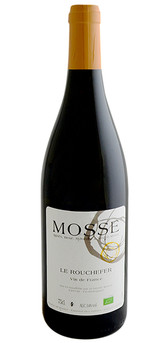Agnes et Rene Mosse Rouchefer 2021 (750ML)
Other Details
Critic Scores, Reviews & Descriptions
92 WS
Alluring and fresh, with beautiful kumquat, crisp apple and nectarine notes complemented by a glaze of honey. Shows good tension and energy through the clean finish, while a whiff of smoke, sea salt and intense minerality add range. Impressive. Drink now through 2032. 450 cases made, 120 cases imported. - KB, Wine Spectator
This wine is produced within the Anjou appellation but is intentionally declassified as VDF. Le Rouchefer is a single vineyard bottling from a 1.66 hectare parcel of the same name. An ample and generous Chenin, balanced by a vibrant minerality, the light maceration gives it structure.
Agnès and René Mosse, along with their sons Joseph and Sylvestre, live and work in the village of St-Lambert-du-Lattay, a village in the Coteaux-du-Layon area of Anjou. Layon is a small tributary to the Loire that lazily digs its way through well exposed and drained hills of schist and sandstone. Its micro-climate allows for a long hang-time, and when the mornings are foggy in the fall, with no rain, botrytis develops easily on the Chenin grapes.
Before becoming vignerons, the Mosse had owned a wine-bar/retail shop hybrid in Tours. They credit the great vignerons they met there, among them Jo Pithon and François Chidaine, as the impetus to become winemakers. The couple studied viticulture and oenology at the agricultural lycée in Amboise where two of their teachers were Thierry Puzelat (Clos du Tue-Boeuf) and Christian Chaussard (Domaine le Briseau).
After graduating, the Mosse spent two years working in Côte-de Beaune before buying their estate in St-Lambert in 1999. They currently work 17 hectares of vines, most of them planted with Chenin Blanc (9HA), and Cabernet Franc(3 HA), the rest planted with Gamay, Chardonnay, Grolleau Gris and Noir.
They adopted organic viticulture techniques from the start, plowing between and under the rows, and use biodynamic preparations to treat the vines and soil. In their area of "Anjou Noir" (Black Anjou, so called because of the dark color of the soils of slate and volcanic rocks), the soils are shallow, with subsoils of schist and sandstone, and varying amounts of clay on the surface.
With all the efforts put into vineyard work, it is equally important to them to vinify in a natural fashion, and they are particularly attentive to minimizing manipulations and the use of sulfur. All the wines are barrel-fermented and aged. The whites usually go through their malolactic fermentation. The barrels are renewed as needed, but are always older as to not impart oak flavors.
 Loading... Please wait...
Loading... Please wait...




